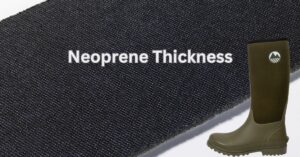Are Wellies Effective for Walking on Ice
Wellies, also known as Wellington boots, are a popular choice of footwear for outdoor activities in wet and muddy conditions. They are made of rubber, which makes them waterproof and durable. However, when it comes to walking on ice, many people wonder if wellies are a good option.
The answer is not straightforward. While wellies can provide good traction on snow and slush, they may not be the best choice for walking on ice. The reason is that the soles of wellies are typically made of rubber, which can become slippery on smooth and hard surfaces. Nonetheless, some wellies are designed with special treads or studs that can improve grip on ice.
Are Wellies Good for Ice?
When it comes to walking on ice, choosing the right footwear is crucial. Wellies, also known as rubber boots or rain boots, are a popular choice for many people. But are they good for walking on ice? Let’s take a closer look.
Benefits of Wearing Wellies on Ice
Wellies are made of natural rubber or neoprene, which makes them sturdy and durable. They are also waterproof, which means that your feet will stay dry even in wet and slippery conditions. Additionally, some wellies come with insulation or lining made of wool or nylon, which can keep your feet warm in cold weather.
One of the main benefits of wearing wellies on ice is their good grip. Most wellies have a rubber sole with a deep tread pattern that provides excellent traction on slippery surfaces. This can help prevent slips, falls, and injuries.
Drawbacks of Wearing Wellies on Ice
While wellies have many benefits, they also have some drawbacks when it comes to walking on ice. One of the main issues is that they are not very comfortable for extended periods of walking. The lack of support and cushioning can lead to fatigue, blisters, and foot pain.
Another drawback of wellies is that they can be bulky and heavy, which can make it difficult to move quickly or change direction. This can be especially problematic in situations where you need to react quickly to avoid slipping or falling.
Finally, wellies are not the best choice for all types of ice. If you are walking on very slippery or uneven surfaces, such as ice rinks or hiking trails, you may need more specialized footwear, such as hiking boots or ice cleats.
In conclusion, wellies can be a good choice for walking on ice, especially if you need waterproof and slip-resistant footwear. However, they may not be the most comfortable or versatile option, and you should consider other factors such as size, brand, and sole type when choosing the best wellies for your needs.
Best Selling Muck Ice Boots
Last update on 2025-03-05 / Affiliate links / Images from Amazon Product Advertising API
Factors to Consider When Choosing Wellies for Ice
When it comes to selecting the right wellies for ice, there are a few factors that one should consider. These include the material, sole, and insulation of the wellies. Here is a breakdown of each of these factors:
Material
The material of the wellies is an important consideration when it comes to selecting the right wellies for ice. Rubber is the most common material for wellies, but it is not the best for icy conditions. Instead, wellies made from jersey or sheepskin are better suited for icy conditions. These materials are more insulating and will keep the feet warm in cold weather.
Sole
The sole of the wellies is also an important factor to consider when selecting wellies for ice. A wellie with a good grip is essential for walking on icy surfaces. Look for wellies with a deep tread and a non-slip sole. Some wellies also come with adjustable straps that can help to keep the wellies in place and prevent slipping.
Insulation
Insulation is another important factor to consider when selecting wellies for ice. Wellies with a good level of insulation will help to keep the feet warm in cold weather. Look for wellies with a thick lining or sheepskin insulation. It is also important to consider the size of the wellies. Wellies that are too tight will not allow for enough air circulation, which can cause the feet to become cold.
In conclusion, when selecting wellies for ice, it is important to consider the material, sole, and insulation of the wellies. Wellies made from jersey or sheepskin, with a non-slip sole and good insulation, are ideal for walking on icy surfaces. Additionally, it is important to ensure that the wellies fit well and are not too tight.
Tips for Wearing Wellies on Ice
When it comes to wearing wellies on ice, there are a few tips to keep in mind to ensure your safety and comfort. Here are some things to consider:
Choose the Right Wellies
Not all wellies are created equal, and some are better suited for icy conditions than others. Look for wellies with a good grip on the sole, as this will help prevent slips and falls on icy surfaces. Additionally, consider investing in wellies with a warm lining or insulation, as cold feet can quickly become uncomfortable and even dangerous in icy conditions.
Wear the Right Socks
When wearing wellies on ice, it’s important to choose the right socks to keep your feet warm and dry. Look for socks made from wool or other insulating materials, as these will help keep your feet warm even if they get wet. Additionally, consider wearing two pairs of socks for extra warmth and cushioning.
Take Short, Steady Steps
When walking on ice in wellies, it’s important to take short, steady steps to maintain your balance. Avoid taking long strides or running, as this can increase your risk of slipping and falling. Additionally, try to walk on the flattest, most stable surfaces possible, and avoid stepping on any areas that appear particularly icy or slippery.
Use Ice Grippers
If you frequently wear wellies on icy surfaces, consider investing in a pair of ice grippers to attach to the bottom of your boots. These can provide extra traction and stability, reducing your risk of slipping and falling.
By following these tips, you can stay safe and comfortable when wearing wellies on ice. Remember to always exercise caution and take things slow, especially when conditions are particularly icy or slippery.
Conclusion
In conclusion, wellies are not the best option for walking on ice. While they may provide waterproof protection, they lack the necessary traction to walk safely on slippery surfaces. However, there are some wellies that are better suited for winter conditions than others.
When choosing wellies for winter weather, it is important to look for those with a non-slip sole and good grip. Some wellies have special features such as thermal insulation or removable fleece lining, which can help keep feet warm in cold temperatures.
It is also important to consider the fit of the wellies. A well-fitting pair will provide better support and reduce the risk of slipping or sliding on ice. It is recommended to wear thick socks with wellies to provide additional warmth and cushioning.
Overall, while wellies may not be the best choice for walking on ice, they can still be a useful addition to a winter wardrobe. It is important to choose a pair with the right features and fit for the intended use.










